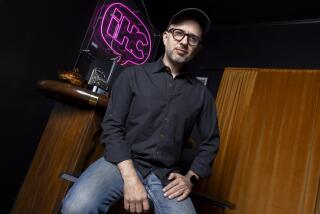Music and Dance Reviews : ‘Lifeleap: A Celebration of Life’ at Wilshire Ebell
- Share via
With the laudable purpose of raising money to benefit AIDS Project Los Angeles (APLA), eight local choreographers collaborated in “Lifeleap: A Celebration of Life Through Dance” at the Wilshire Ebell Theater on Friday.
Under the circumstances, one expected works of the deepest honesty, probity and soul-searching. What one got too often were works devoted to the body beautiful and flashy, vacuous, high-energy choreography, not all that securely danced.
For the record:
12:00 a.m. Sept. 16, 1988 For the Record
Los Angeles Times Friday September 16, 1988 Home Edition Calendar Part 6 Page 25 Column 3 Entertainment Desk 1 inches; 28 words Type of Material: Correction
“Ball of Confusion” choreographer Marguerite Pomerhn-Derricks was misidentified in a review of “Lifeleap: A Celebration of Life Through Dance” at the Wilshire Ebell Theatre in Monday’s Calendar.
According to program notes, the 11-part evening was designed to trace “a voyage of discovery” of “the different aspects of (the AIDS) experience.” James Woodbury strongly danced/acted the central role of a teen-ager with AIDS.
At the beginning, when his sickness became known, he was cast out of the high-voltage, jazz chorus-line workout of Frances Morgan-Chapman’s “Ball of Confusion.” At the end, he was inducted into a hokey, Bejart-esque vision of heaven (corps of bare-chested men in white skirts, women in tight unitards) in Jane Cassell’s “Safe Place.” Being a part of the with-it group, apparently, was the ideal in both works.
Some of the choreographers raised more troubling issues. Vincent Paterson evoked an afflicted individual’s nightmares in the vaguely focused “Underneath the Night.” Cassell herself addressed issues of isolation--if a bit too easily--in her “On the Turning Away.” Sarah Elgart, in “Eleventh hour,” deftly traced paranoia traveling through a group potentially as swiftly as the AIDS virus.
But Bill and Jacqui Landrum resorted to pure fantasy in “Other Callings,” with three mysterious figures using magic gestures to help a “weakened” Woodbury dress and take ballet positions before a mirror. Suddenly, however, he was miraculously empowered to dance on his own, and he unleashed a series of brilliant turns to end with a deep reverence before collapsing. A disturbing, cruel idea: art as wish fulfillment.
But Billy Goodson offered probably the most tasteless, if not brainless, idea of all in his group piece “Strana Cultura,” which long reveled in indiscriminate couplings before suggesting there could be any dangerous consequences. This work in particular drew wild applause from the youngish crowd, which had accepted absolutely everything with great enthusiasm.
More to Read
The biggest entertainment stories
Get our big stories about Hollywood, film, television, music, arts, culture and more right in your inbox as soon as they publish.
You may occasionally receive promotional content from the Los Angeles Times.










